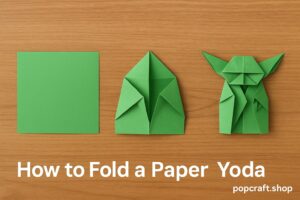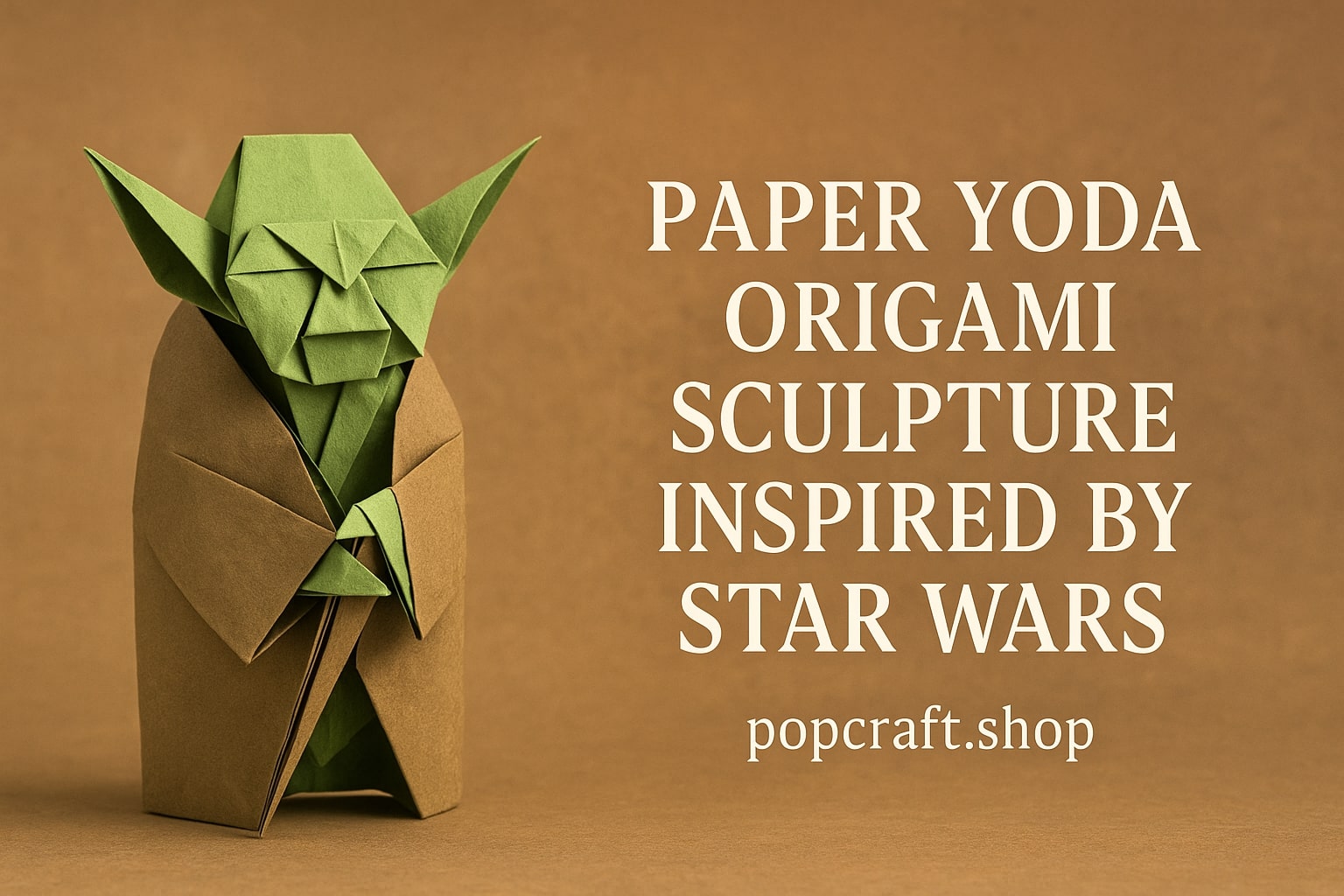Paper Yoda Origami Sculpture Inspired by Star Wars
There’s something strangely satisfying about transforming a flat piece of paper into a pop culture icon. For Star Wars fans, one character often finds himself at the center of that transformation—Yoda. Not the CGI-flashy lightsaber-swinging version, but the quiet, robe-draped sage who delivered one-liners that shaped childhoods and TikTok captions alike.
Origami, the Japanese art of folding paper into expressive shapes, may not seem like it belongs in the same conversation as space battles and Jedi wisdom. And yet, Yoda has become one of the most folded fictional figures of all time. He’s been printed on cereal boxes, projected in 3D, and even baked into cupcakes—but give someone a square sheet of paper, and many instinctively try to fold those unmistakable ears.
But what makes the Paper Yoda more than just a craft project? It’s not just fan art. It’s a conversation between creativity and nostalgia, between patience and precision.
Why Fold Yoda? Why Not Just Buy a Toy?
Because folding a character teaches you more about him than collecting ever could.
With every crease, you notice how Yoda’s form is made of contrast: soft robes and sharp ears, a humble stance hiding immense power. His face, simple yet wise, becomes more than a pop culture symbol—it becomes a challenge to replicate with elegance.
There’s also something deeply personal about folding your own. Mass-produced figurines are everywhere. A folded Yoda? That’s yours. Made by your hands, with your time, and your interpretation.
Not to mention, Yoda represents calm, wisdom, and deliberate action. That aligns perfectly with what origami demands—steady hands, focus, and presence. In fact, many folders say crafting a Yoda is borderline meditative.
What You’ll Need to Get Started
Good news: You don’t need a drawer full of tools. A basic Paper Yoda needs just a few things:
-
Square origami paper: Green is classic, but feel free to play with metallic or textured sheets.
-
A clean surface: You’ll want space to move around without creasing your sheet too early.
-
A bone folder or ruler (optional): These help with sharper, cleaner folds.
-
Tweezers (optional): For the finer details like the nose or robe pleats.
-
A video or diagram tutorial: Even if you’re good at following instructions, having a visual aid helps.
Beginners should start with 6×6 inch paper. It gives enough room to fold cleanly without overcomplicating things. As you get better, smaller paper becomes doable and more impressive.
How to Fold a Paper Yoda (The Simplified Breakdown)

There are dozens of Yoda tutorials online, each with its own level of complexity. Some are designed for kids, others are made for artists who thrive on 80+ steps. If you’re somewhere in between, start with a moderate version.
-
Begin with the basic folds: Diagonal, vertical, and horizontal folds to create your base.
-
Form the ears: Pull out the corners and adjust their angle. Ears give Yoda his shape, so don’t rush.
-
Shape the robe: Pleats along the bottom half of the paper become the robes. Symmetry matters.
-
Define the head: A few folds at the top create Yoda’s brow, forehead, and nose. Optional crimps can add expression.
-
Add finishing touches: Tweak the robe angle, tilt the ears slightly, and stand him upright if you can.
The first one might not look great. That’s normal. But the second one will be better, and the third might actually make you proud enough to gift it.
Intermediate Versions: When You’re Ready for the Next Level

As you get more comfortable, you’ll discover designs that push the envelope—adding more realistic facial features, sculpted folds in the robe, even separate folds for a lightsaber or a tiny hand.
Advanced folders often look to the designs by origami artists like Fumiaki Kawahata, whose Yoda has become a benchmark in the community. These models can take hours and require extreme precision—but the result is a sculpture that looks like it came straight out of Lucasfilm’s design room.
Tips for leveling up:
-
Try wet folding, which adds more curvature and shaping to the face and robe.
-
Use foil-backed paper for dramatic, crisp folds.
-
Fold sections separately (head, body, hands), then assemble.
These techniques allow you to go beyond just copying an image and into creating something that feels alive.
Display Ideas That Show Off Your Work
You folded Yoda. Now what?
Don’t just let it sit in a drawer. There are simple ways to display it that add polish and presence:
-
Mini shadow boxes: Frame Yoda with a black background and a small quote card like “Do or do not. There is no try.”
-
Glass domes: Perfect for protecting intricate models while elevating them to ‘collector’s item’ status.
-
On your bookshelf: Nestled between Star Wars novels or next to your LEGO Millennium Falcon.
-
As a gift topper: Skip the bow. Add Yoda to the ribbon for the most unforgettable present.
Educational and Emotional Value of Folding Yoda
It’s easy to overlook, but crafting something like Yoda has value beyond aesthetics.
You’re developing:
-
Patience: Origami isn’t fast food. It’s slow cooking.
-
Spatial reasoning: Understanding how folds work improves geometry and problem-solving.
-
Emotional control: Mistakes are frustrating, but the art is about staying calm and adapting.
That’s why origami is often used in schools and therapy sessions. And when it’s Star Wars-themed, engagement goes through the roof. Kids and adults alike are more likely to stick with a project when they’re invested in the character they’re folding.
So in a strange way, folding Yoda doesn’t just teach you how to make something—it teaches you how to approach life a little more like he does.
Is It Worth It? Absolutely.
In a world where content is consumed and forgotten in seconds, making something by hand—especially something rooted in nostalgia and meaning—feels like rebellion. A quiet rebellion. The kind Yoda would respect.
The process isn’t perfect. Your folds won’t always line up. Your Yoda might look a little grumpy when he should look wise. But in that imperfection is the real magic.
You’re not folding paper. You’re folding character. History. A bit of yourself.
Quick FAQ
Q: Is Yoda origami beginner-friendly?
Yes, start with a simple model. Plenty of beginner tutorials are out there.
Q: Can I fold Baby Yoda (Grogu) instead?
Absolutely. Many artists offer simplified Grogu tutorials. Slightly different proportions, but adorable results.
Q: What kind of paper is best?
Start with 6×6 inch origami paper. As you improve, try tant, washi, or foil paper.
Q: Where can I find advanced tutorials?
YouTube, origami blogs, and books by creators like Chris Alexander and Fumiaki Kawahata.
Q: How can I make my Yoda stand up?
Try slightly crimping the base folds and adding a small paper base or cardboard platform for support.

